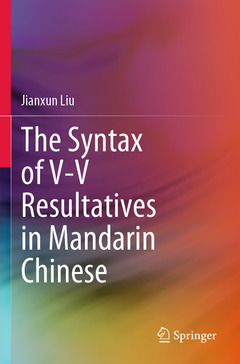Chapter 1: Introduction
1 The empirical domain and basic research questions
2 Arguments and proposals: Preview
2.1 The generation of V-V resultative compounds
2.2 The syntactic structure of V-V resultatives
2.3 The alternation properties of V-V resultatives
3 Theoretical assumptions
4 Outline of the dissertation
Chapter 2: The generation of resultative V-V compounds
1 Introduction
2 Lexicalist vs. syntactic approaches to word formation
2.1 The lexicalist approach
2.2 Word formation in Distributed Morphology: A syntactic approach
3 The inner vs. outer domain hypothesis for the formation of complex words
3.1 The inner vs. outer domain hypothesis
3.2 The crosslinguistic application of the two-domain hypothesis
4 A lexicalist analysis: Y. Li (2005)
5 Generation of resultative and parallel V-V compounds in Mandarin
5.1 Resultative vs. parallel V-V compounds
5.1.1 Parallel V-V compounds
5.1.2 Contrasting properties of resultative and parallel V-V compounds
5.2 An analysis under the two-domain hypothesis
5.2.1 Semantics: Compositionality vs. idiosyncrasy
5.2.2 Nominalizations
5.2.3 Free vs. bound component morphemes
5.2.4 Productivity vs. semi-productivity
5.2.5 Adverbial modification
6 Conclusion
Chapter 3: The syntactic structure of Mandarin V-V resultatives: An event-mapping
approach
1 Introduction
2 The event-mapping approach to argument structure
2.1 Lexicalist vs. syntactic approaches to argument structure
2.1.1 The lexicalist approach
2.1.2 The syntactic approach: The autonomy of syntactic structure
2.2 The event-mapping approach to argument structure
2.2.1 Event-structure decomposition of verbal semantics
2.2.2 The event-mapping approach to argument structure
2.2.2.1 Travis (2010) and Ramchand (2008)
2.2.2.2 Lin (2004)
2.2.2.3 Marantz (2013)
2.2.3 Assumptions of my analysis
3 Previous studies of V-V resultatives in Mandarin
3.1 Weakly decompositional analyses of Mandarin V-V resultatives
3.2 Lin (2004): An event-mapping approach
4 Syntactic structure of V-V resultatives in Mandarin: The evidence from adverbial
modification properties
4.1 The syntactic structure of object-oriented V-V resultatives
4.1.1 The evidence for the vCAUSEP
4.1.2 The evidence for the vBECOMEP
4.1.3 The absence of vBEP
4.1.4 An intermediate summary
4.2 The syntactic structure of subject-oriented V-V resultatives
4.2.1 Adverbial modification properties of subject-oriented V-V resultatives
4.2.1.1 V1: Unavailable for adverbial modification
4.2.1.2 Adverbial modification of V2
4.2.1.3 The impossibility of state-modifying adverbs
4.2.2 Subject-oriented V-V resultatives with surface object
5 Conclusion
Chapter 4: The external argument and alternations of V-V resultatives
1 Introduction
2 The properties of the subject of V-V resultatives
2.1 Theoretical background: The different structures of causatives
and noncausatives
2.1.1 Pylkkänen (2008): Causatives and noncausatives differ in
appearance/absence of vCAUSE
2.1.2 Alexiadou, Anagnostopoulou & Schäfer (2015):
Causatives and noncausatives differ in the appearance/absence of Voice.
2.2 The properties of the subject of resultatives
2.2.1 The external argument in object-oriented resultatives
2.2.2 Subject-oriented resultatives: The absence of an external argument
3 The alternation of resultative V-V compounds
3.1 The de-causativization of object-oriented V-V resultative compounds
3.2 The causativization of subject-oriented resultative V-V compounds
3.2.1 Summary of the proposal
3.2.2 Direct Causation Condition: Rappaport Hovav & Levin (2012)
3.2.3 The alternation properties of subject-oriented V-V resultatives:
My analysis
4 Conclusion
Chapter 5: Concluding Remarks
1 The present work: Brief summary and its significance
2 Future studies
References




